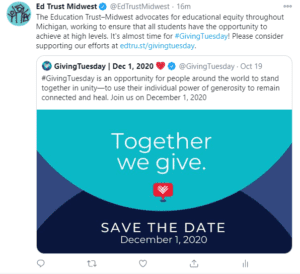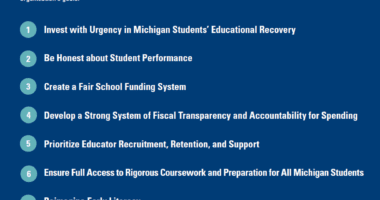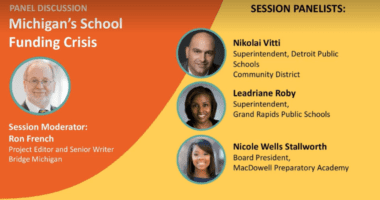Equity Edition: Amid COVID-19, Millions of Students May Have Stopped Attending School
Amid COVID-19, Millions of Students May Have Stopped Attending School
Interrupted learning may have dire consequences for student learning, especially for the most underserved students.
When schools closed in March amid the COVID-19 pandemic, some school districts across the nation quickly pivoted to distance learning and instruction. Yet other districts struggled not only to provide the resources for students to learn remotely, but had difficulty even locating their students — especially those who are the most vulnerable — and reconnecting them to school.
Today, that leaves a troubling unanswered question in Michigan and across the nation: how many students are still missing from school?
On Nov. 15, Governor Whitmer and Michigan Department of Health and Human Services Director Robert Gordon announced new COVID-19 restrictions as positive cases continue to increase drastically in Michigan, including shuttering in-person instruction in high schools and colleges, with the goal of saving lives.
And yet, the phenomenon of interrupted learning may have a devastating impact for millions of students across the nation. According to a Bellwether Education Partners analysis, as many as 3 million students nationally may have stopped attending schools due to abrupt – and now intermittent – closures, as well as the uneven access to instruction that followed. This is a massive number of children who may suffer long-term consequences such as a decline in academic achievement or lifetime wages.
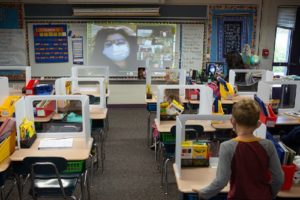
Photo by Allison Shelley for American Education: Images of Teachers and Students in Action
Interrupted learning is expected to exacerbate longstanding opportunity and achievement gaps for the most underserved students, including Black, Latino and low-income students. According to a report by McKinsey & Company, school closures may result in Black students falling behind by 10.3 months, Hispanic students by 9.2 months, and low-income students by more than a year. The analysis suggested that existing achievement gaps could grow by 15 to 20 percent.
The reasons for the anticipated growth in gaps are varied, including lack of access to reliable wi-fi, limited digital devices for all the students in the family, lack of access to a suitable place for learning and other barriers. For instance, an analysis by the Education Trust-Midwest showed that in communities across the state, access to devices and reliable broadband vary greatly, disproportionately affecting students of color, students from low-income backgrounds and students in rural communities.
This uneven digital access also builds upon the challenges and inequities millions of American children already faced in accessing online resources to complete homework assignments, improving digital literacy skills and continuing or accelerating their learning at home.
And with the educational status of millions of students simply unknown, the impact may be far more devastating.
Detroit Public Schools Community District last month reported that enrollment was down by 3,000 students, leading Superintendent Dr. Nikolai Vitti to share his concerns over chronic absenteeism, the potential impact on student achievement and parents’ ability to support learning at home. Districts like Flint Community Schools and Kalamazoo Public Schools also reported troubling enrollment declines.
At the time, Vitti was urging more face-to-face instruction; however, rising COVID cases recently forced the district to announce a new system-wide closure — even before the Governor’s announcement this past weekend.
School districts across the state are facing similar decisions, while still facing enormous pressure to meet students’ varied needs. And yet the disparities remain, with some wealthier districts having more resources, capacity and technological infrastructure to respond.
“The COVID-19 pandemic continues to magnify the profound differences between what affluent districts can offer their students compared to chronically under-resourced districts,” said Amber Arellano, executive director of the Education Trust-Midwest.
In March, the Education Trust-Midwest called on leaders to enact a Marshall Plan for public education to respond to the crisis an address longstanding inequities.
Eight months into the pandemic that shows no signs of slowing, it’s critical for the federal government, state, school districts, and community organizations to redouble efforts and join together to find students who have gone missing from school, ensure they re-engage in learning and provide the supports to help them achieve, Arellano said.
“We must act with great urgency to find and support every student that has become disconnected from school to ensure that our most underserved students do not fall further behind,” Arellano said. “This will require all forces coming together for the safety of our state’s schoolchildren – and their future success.”
To best support school districts in allocating local, state, and federal resources to ensure all students have access to high-quality learning, we continue to urge states to take the following actions:
- Create and maintain centralized, clear, and regular communication and real-time data reporting to community stakeholders.
- Maintain and strengthen critical supports for students and families in need.
- Provide guidance and resources to districts on educational services for vulnerable populations.
- Support districts to develop plans with short- and long-term solutions to address COVID-19 challenges.
- Ensure underserved student groups, including low-income students, English learners, and students with disabilities, are prioritized in budget decisions.
Every Student Matters: Ed Trust joins other Michigan education agencies to provide a toolkit for districts to find students
This month, The Education Trust-Midwest joined other education agencies to provide a toolkit to aid school districts in finding and re-engaging students who may have become disconnected from schooling, a phenomenon that could have a devastating and long-lasting impact on their learning.
Called Every Student Matters, the toolkit provides strategies that districts may use in partnership with other organizations and community partners to locate missing students and help reconnect them to school.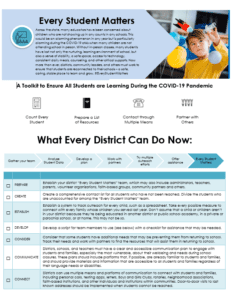
Some suggested strategies included:
- Create a comprehensive contact list for all students who have not been reached. Divide the students who are unaccounted for among an “Every Student Matters” team.
- Use multiple means and platforms of communication to connect with students and families, including personal calls, texting apps, letters, Boys and Girls Clubs, rotaries, neighborhood associations, faith-based institutions, and other individuals and institutions within communities. Door-to-door visits to last known addresses should be implemented when students cannot be reached.
- Reach students using McKinney-Vento homeless liaisons and foster care liaisons to continue to identify and serve homeless and foster care students, and to maintain positive relationships that students have built with staff members.
- Encourage the registration of home school children by those parents who choose to home school their children.
- Encourage school leaders and teachers to maintain two-way communication with their students and families and establish norms for staff members on how and when to communicate with students.
- Create a model for communicating in multiple languages.
- Work with school specialists to communicate with families regarding ways to deliver services while schools are closed, including holding IEP and 504 meetings remotely, and plans to deliver services once students return to school.
Organizations signing onto the toolkit included the Michigan Department of Education, Michigan Association of Superintendents & Administrators, The Education Trust-Midwest, Middle Cities Education Association, the Michigan Association of Intermediate School Administrators, Michigan Association of Secondary School Principals, Michigan Elementary and Middle School Principals Association, Middle Cities Education Association, Michigan Education Association, AFT Michigan, Michigan Association of School Boards, Michigan School Business Officials, and Michigan’s Charter School Association.
Dr. Michael Rice, Michigan’s superintendent of public instruction, recently addressed the critical issue of missing students during a State Board of Education meeting, underscoring the importance and urgency to count, locate and educate Michigan’s missing students.
“This ability to ensure that all students are safe and educated is vital, especially in a pandemic,” he said.
#GivingTuesday campaign helps us work toward educational equity and excellence in Michigan.
The Education Trust–Midwest advocates for educational equity throughout Michigan, working to ensure that all students have the opportunity to achieve at high levels, but particularly children of color and those from low-income backgrounds.![]()
For #GivingTuesday, a special day of global giving, we are reminded of the need to close opportunity gaps for our most underserved students. Especially now, as long-standing inequities in education have been exacerbated by the COVID-19 pandemic, it is critical that WE WORK TOGETHER to increase opportunities for all students in Michigan so they receive rigorous learning to advance their educational growth and development.
#GivingTuesday will be held on December 1, and we are asking for your support to help us in our critical work toward educational equity and excellence in Michigan. With your gift, we will be able to expand our capacity and resources needed and advance our mission during this unprecedented time. Please give today by clicking here, or edtru.st/givingtuesday.
It is only because of a generous community – and advocates like you — that together we are able to progress in our service to students statewide and create a meaningful, lasting impact on their educational futures.
Give the gift of opportunity today!
In partnership toward equity,
Amber Arellano and The Education Trust-Midwest Team
Noteworthy News
- ‘How am I going to do this again?’: Michigan families squeezed as COVID cases skyrocket and classrooms shut down, Koby Levin, Chalkbeat Detroit
- New hubs in the Detroit school district will help families with technology and community resources, Eleanore Catolico, Chalkbeat Detroit
- Survey: Teachers and Students Are Struggling With Online Learning, Sarah Schwartz, Education Week

